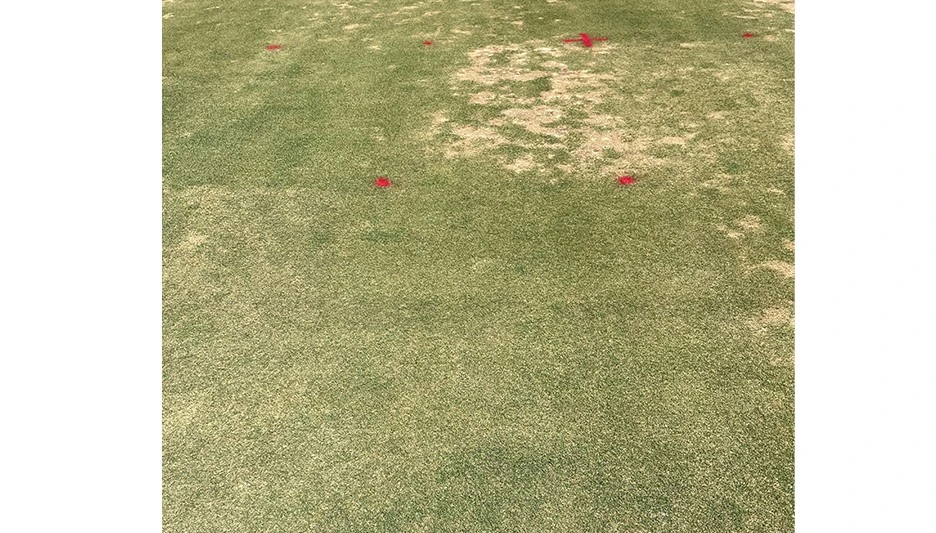
Courtesy of BASF
Fungicides account for a significant portion of a golf course maintenance budget and not understanding how to use them properly can prove costly for a superintendent.
The first — and often best — reference point in applying products as intended lurks directly in front of an applicator.
“There are a lot of educational resources available,” says BASF senior technical specialist Emma Lookabaugh, PhD, “but the fungicide label is where you would start. Most labels are fairly comprehensive. They not only tell you how to apply products and what rates to use for specific diseases, but they also tell you what not to do.”
Labels are carefully constructed by manufacturers who spend years researching, developing and positioning fungicides to help superintendents. Proven manufacturers such as BASF also offer highly trained technical and sales specialists who study solutions in myriad conditions and speak with superintendents everywhere about product usage and performance. Add in the brainpower of university extension specialists, and ample resources exist to ensure fungicides are being applied effectively, thus saving superintendents two things they can’t afford to squander: money and labor.
Once base knowledge is obtained from the label, a few technical tasks must be executed. For starters, a disease or potential disease threat must be properly diagnosed. “Taking time to send in samples and get an official diagnosis before you treat will save you time and money in the long run,” Lookabaugh says. “You won’t be wasting those apps and you won’t have to go in and re-treat a week later with the correct product.”
Depending on the disease, the next step is understanding the relationship between the targeted disease and moisture. “For some diseases like take-all root rot and fairy ring, you need to water in the application immediately to get good control,” Lookabaugh says. “Failure to water in with the right amount of water can be the difference between excellent control or complete failure.”
A correlation also exists between rate ranges and efficacy. “With some diseases, like dollar spot, your rate range might be lower than what it is for soil-borne diseases,” Lookabaugh adds. “Always make sure you are applying the right rate for the specific disease you’re targeting. When disease pressure is high, you’ll want to be on the higher end of the rate range to extend control.”
Since being launched in 2019, BASF has learned plenty about where, when and how to use Maxtima® fungicide, a DMI that is safe on cool- and warm-season turf species during any point of the growing season. Maxtima® fungicide is labeled for control of dollar spot, anthracnose, leaf spots, brown ring patch, mini ring, fairy ring, take-all root rot, spring dead spot, take-all patch and summer patch.
“For foliar diseases, like dollar spot, anthracnose and some of your leaf spots, we recommend using spray volumes of two to four gallons per 1,000 square feet for best results,” Lookabaugh says. “But let’s be real, most people are probably going out closer to one to two gallons per 1,000 square feet, especially on fairways, and we’re seeing really good performance. For soil-borne diseases like take-all root rot, spring dead spot, summer patch and especially fairy ring, we recommend you water in with at least a quarter inch of irrigation immediately following the application. Using a regular soil wetting agent every two weeks will help maximize efficacy. For best results, apply Maxtima® fungicide preventatively before you see symptoms.”
Maxtima® fungicide can be applied on any part of the golf course, although best-use tendencies have emerged over the past three years.
“If we’re talking cool season, it works best on bentgrass fairways for dollar spot, anthracnose and patch diseases, and it’s also very popular on bentgrass and Poa greens, where anthracnose can reduce turf quality in the summer months,” Lookabaugh says. “Maxtima delivers excellent control of fairy ring, take-all root rot and spring dead spot on Bermudagrass greens. On Bermudagrass fairways, it provides a cost-effective solution for spring dead spot and even some of your leaf spot diseases. It’s also a great foundational application for dollar spot programs on seashore paspalum fairways in the South.”





